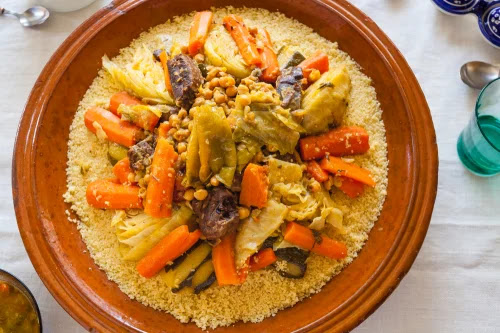Couscous is a versatile and popular staple food originating from North Africa, where it has been a dietary cornerstone for centuries. Made from semolina wheat, couscous consists of tiny granules or pearls, and it serves as a base for many dishes in Moroccan, Tunisian, and Algerian cuisines. Its simplicity, quick preparation, and adaptability make it a beloved ingredient worldwide.
.webp) |
| What is Couscous? |
What is couscous?
Couscous is a traditional North African staple made from semolina wheat, shaped into tiny granules or pearls. It comes in three main types: traditional (smallest), Israeli (medium, chewy), and Lebanese (largest, pasta-like). Quick to prepare, couscous is versatile and used in various dishes, including side dishes, salads, stews, and even sweet recipes. It is nutritious, providing carbohydrates, some protein, and fiber, though it is not gluten-free.
Types of Couscous
Couscous comes in various types, each with distinct characteristics and uses:
Traditional Couscous: The smallest variety, is made from finely ground semolina. It has a delicate texture and cooks very quickly, typically in about 5 minutes.
Israeli Couscous: Also known as pearl couscous, this type is larger and has a chewy texture. It is often toasted to enhance its nutty flavor and takes about 10 minutes to cook.
Lebanese Couscous: The largest of the three, Lebanese couscous (or Moghrabieh) resembles small pasta and requires a longer cooking time. Its hearty texture makes it ideal for stews and slow-cooked dishes.
How is Couscous Made?
Traditionally, couscous is made by sprinkling water over semolina flour and rolling it into tiny granules by hand. These granules are then steamed until fluffy and tender. Modern couscous is often pre-steamed and dried, allowing for quick and easy preparation by simply rehydrating it with hot water or broth.
Nutritional Value
Couscous is a decent wellspring of carbs, giving energy to the body. It is low in fat and contains some protein and fiber. Enriched couscous varieties may include additional vitamins and minerals such as iron, selenium, and B vitamins. However, it is not gluten-free, making it unsuitable for those with celiac disease or gluten sensitivity.
How to Cook Couscous
Preparing couscous is incredibly straightforward:
Traditional Couscous: Combine 1 part couscous with 1.5 parts boiling water or broth. Cover and allow it to sit for 5 minutes, then cushion it with a fork.
Israeli Couscous: Cook it like pasta in boiling water or broth for 8-10 minutes, then drain.
Lebanese Couscous: Simmer in water or broth for about 15-20 minutes until tender.
Culinary Uses
Couscous’s mild flavor makes it a perfect canvas for various seasonings and ingredients. It can be:
A Side Dish: Served plain or with herbs and spices alongside meat, fish, or vegetables.
A Base for Salads: Used in dishes like tabbouleh, mixed with fresh vegetables, lemon juice, and olive oil.
In Stews and Tagines: Paired with slow-cooked meats, vegetables, and rich sauces.
For Breakfast: Sweetened with honey, cinnamon, and dried fruits.
Cultural Significance
In North African cultures, couscous is more than just food; it symbolizes hospitality and tradition. It is often prepared for family gatherings, celebrations, and religious festivals, reflecting the community’s rich culinary heritage.
Is couscous healthier than rice?
Couscous and rice both have health benefits, but their nutritional profiles differ. Couscous is lower in calories and contains more protein than white rice, making it a good option for weight management and muscle health. However, brown rice has more fiber and essential nutrients like magnesium. The choice depends on dietary needs and preferences.
Is couscous Algerian or Moroccan?
Couscous is a traditional dish rooted in the Maghreb region, including Algeria, Morocco, Tunisia, and Libya. While it is a staple in Moroccan and Algerian cuisines, no single country can claim exclusive ownership, as it is a shared culinary heritage of North Africa.
Is couscous healthy?
Couscous is a healthy option as it is low in fat, contains moderate protein, and provides essential nutrients like selenium. It can support heart health and immunity. However, it is low in fiber compared to whole grains, so pairing it with vegetables or legumes enhances its nutritional value.
What is the disadvantage of couscous?
The main disadvantage of couscous is its low fiber content compared to whole grains, which may not support digestion as effectively. Additionally, because it is made from refined wheat, with a higher glycemic index, it potentially causes blood sugar spikes. It is also unsuitable for those with gluten intolerance or celiac disease.
Is couscous a carb or protein?
Couscous is primarily a carbohydrate, as it is made from wheat semolina and provides energy through its carb content. While it does contain some protein, it is not as protein-rich as legumes or meat. It’s best combined with other protein sources for a balanced meal.
Tips and Variations:
To enhance couscous, use flavorful cooking liquids like broth or add spices such as cumin or turmeric. Mix chopped vegetables, dried fruits, nuts, or herbs like parsley for texture. Variations include whole-grain couscous for added fiber or pairing it with proteins like chicken or chickpeas for a complete meal. Experiment with sweet or savory combinations to suit your taste.
Ingredients:
- 1. Ingredients needed:
- 1cup couscous
- 1 cup boiling water or broth
- 1 tablespoon olive oil or butter (optional)
- Salt to taste
Instructions:
1. In a heatproof bowl, combine couscous with olive oil or butter and a pinch of salt.
2. Pour boiling water or broth over the couscous.
3. Cover the bowl tightly with a lid or cling wrap and let it sit for 5-10 minutes.
4. Cushion the couscous with a fork to isolate the grains.
3. Serve:
Enjoy plain or mixed with vegetables, proteins, or spices for added flavor!
 |
| What is Couscous? |
